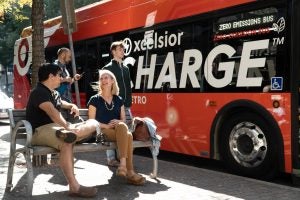Multi-state “action plan” on zero-emission trucks, buses is robust, but key additions are needed
 Last month truck manufacturers, environmentalists and others shared their thoughts on a multi-state draft action plan to spur zero emission medium- and heavy-duty trucks in 17 states, the Province of Quebec and Washington D.C.
Last month truck manufacturers, environmentalists and others shared their thoughts on a multi-state draft action plan to spur zero emission medium- and heavy-duty trucks in 17 states, the Province of Quebec and Washington D.C.
The plan, spearheaded by the Northeast States for Coordinated Air Use Management and developed by signatory states, was the culmination of months of educational webinars and stakeholder outreach and demonstrated the fruits of that labor. It was comprehensive and reflected the inclusion of a diverse array of perspectives and ideas.
The model action plan could be further strengthened to provide a roadmap for states that adequately addresses the climate and health imperative created by diesel trucks and buses.
Multi-state “action plan” on zero-emission trucks, buses should be strengthened Share on XEDF highlights the following as critical goals:
- State plans to transition to zero-emission vehicles have to be firmly rooted in equity. A set of solutions that fails to incorporate the recommendations of the communities that disproportionately breathe in dirty air from diesel trucks and buses should be a non-starter. Before formulating a plan that is tailored to a state’s individual circumstances — a process which signatory states should undertake — robust and effective outreach to communities and environmental justice advocates needs to be conducted, and implementation needs to ensure ongoing interaction with those same groups.
- States should plan for 100% new zero-emission trucks and buses by 2035. It is well-documented that diesel trucks and buses cause significant air quality and climate impacts, with disproportionate effects in communities closest to truck-attracting facilities, freight corridors and ports. The severity of the pollution created by diesel trucks and buses begs a bold target. Having states commit to 100% sales of zero-emission trucks and buses by 2035 is necessary and feasible. As a recent report from EDF makes clear, the technology to make the transition is available and increasingly economically favorable, even from an upfront cost perspective, but a clear line in the sand needs to be drawn in conjunction with ambitious policies that aid in the achievement of that target. Achievement of such a target would bring to bear the significant emissions reductions and economic benefits inherent in a transition in a more timely way.
- The school bus transition should move even more quickly. Relatedly, the transition to 100% new zero-emission school buses should happen by 2027. School buses are a perfect use case for a transition to zero-emission alternatives, given their long dwell times and reliable routes. As well, the fuel and maintenance savings associated with electric buses makes economic sense for school districts — and prioritizes the health of children more vulnerable to the effects of air pollution. Policies should recognize these benefits and move apace.
- Foundational policies must be prioritized. While a full suite of policies that complement each other will be necessary to effectively transition the medium- and heavy-duty vehicle market — including things like incentives, effective charging station deployment, and marketing, education, and outreach — standards that are designed to reduce emissions must be front and center. By sending clear signals to manufacturers and fleets that they must transition to cleaner and zero-emission vehicles through regulations like the Advanced Clean Trucks, Heavy-Duty Omnibus, and Indirect Source rules, states can ensure the market is reliably moving in a way that protects people and the environment, while creating economies of scale that make a decarbonized transportation future more economically feasible.
- The action plan should reflect the intertwined nature of the EV ecosystem. Getting to 100% zero-emission trucks and buses will involve a coordinated ecosystem of actors, including advocates, utilities, state decisionmakers and industry. Organizing a roadmap that supports these actors to cross-collaborate and communicate will ensure greater success in meeting the terms of the MOU.
- The specter of supply chain issues should not be an excuse for lack of forward momentum. The action plan brings up supply chain issues and suggests that shortages could work against expansion of the market. However, there is a risk of putting too much stock in an argument that opponents of a zero-emission future are using. There is no tangible reason to believe the supply chain shortage will exist many years in the future, when key policies like the Advanced Clean Trucks rule will begin to be implemented. Moreover, supply chain issues are not limited to electric vehicles — internal combustion vehicles will also be impacted. As well, research and development is constantly occurring, bringing new technologies to the market that can diversify the battery supply chain and help avoid future material shortages. Continuing to have strong policies in place that aid the market will be essential.
The draft action plan presents a comprehensive roadmap for states to transition to zero-emission trucks and buses. With some feasible but critical changes, states will be on their way to a zero-emission future that adequately addresses the climate and health imperative created by diesel trucks and buses.










